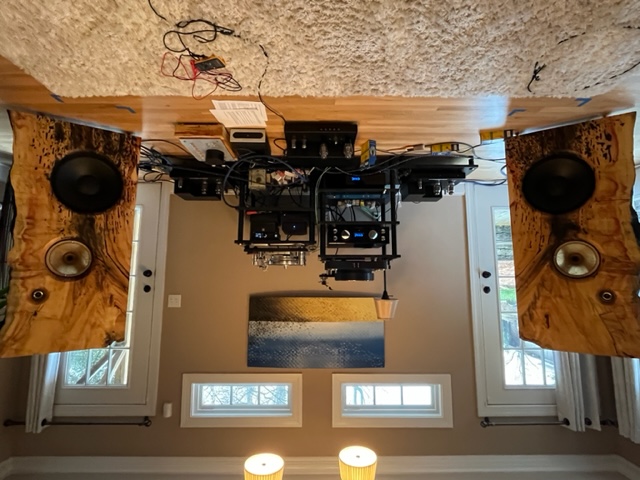Treehaus Audiolab - National Treasure Loudspeaker System
Open baffle with a few twists
I like to go to the lunch buffet at Nawab, a local Indian food restaurant. I have my favorites. But I also trust Nawab to have a quality kitchen that will not likely cook up trash, so sometimes I’ll try something more exotic.
Speakers are no different - they exist on a quality and taste continuum. Of course, most audiophiles have a favorite, but some of us are willing to sample the offerings on the sonic buffet as long as it's in our window of acceptability. And occasionally, something that seemed vaguely unappealing might surprise us.
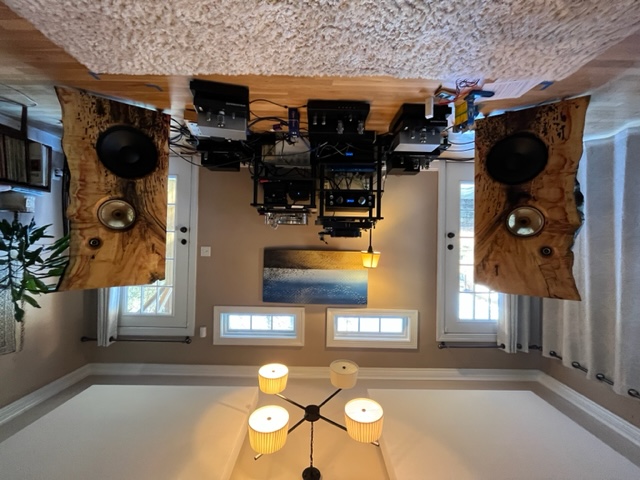
This mindset attracted me to the Treehaus Audiolab - National Treasure loudspeakers. Current prices start at $19,000. I heard them a few years ago at Capitol Audio Fest in Washington, D.C., and again at the 2022 CAF. This last time I decided to take the chance on a review.
I say chance because I wasn’t sure the Treehaus design ethos would be on my speaker buffet. Yet, I couldn’t deny my attraction when listening to them at shows. What would they sound like in my room? I knew they wouldn’t be raisin-filled coleslaw, but would I enjoy Monkfruit Massala? Maaaybe.
So What Exactly Do We Have Here?
Well, for starters, all Treehaus speaker systems are built around the same concept: an open-baffle, bi-amp-able design. A live-edge wood baffle houses a full-range field coil driver with added super-tweeter and a 15” cone low-frequency driver. Okay.
I’ll quote the Treehaus website:
The heart of the speaker is the main full-range field-coil driver produced by Atelier Rullit. The foundation of these drivers rests in Klangfilm and Telefunken field coils. They are meticulously rebuilt, redesigned, “restomodded” to transform into some of the best drivers available at any price. Utilizing old German copper and ultralightweight “Aero” and “Super Aero” papers for the cone, voice coil, and whizzer, they are quick, exact, detailed, and pure. The incredible strength of the high voltage field coil and the low mass of the voice coil and cone assembly produces a driver that is like a fine sports car. To quote Colin Chapman, “simplify, and then add lightness.” These are not drivers that require big power to muscle around your favorite tracks; they let the music flow briskly through them.
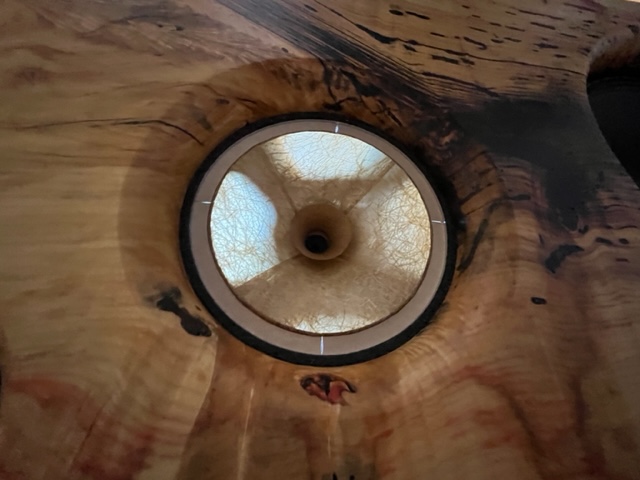
Next, the design uses a Fostex T90A Alnico magnet super-tweeter to add “air” to the full-range driver. The Fostex uses a gentle passive crossover slope starting around 16 kHz to meld with the full-range driver. In addition, the super-tweeter has an L-pad style level control to adjust for different rooms and listeners’ tastes.
When I turned the level control up and down, I heard a fair amount of output in the 10-12K range, corresponding to the stated 1st order/6 db per octave slope at 16K.
The National Treasure uses the 15” woofer to fill out the low-frequency foundation of a recording - separately powered by whatever amp you’d like to use. I’ve seen Treehaus Audiolab use a pair of Schitt audio power amps at shows. For the review, I used a Bel Canto 500S that I keep around as a spare utility amp.
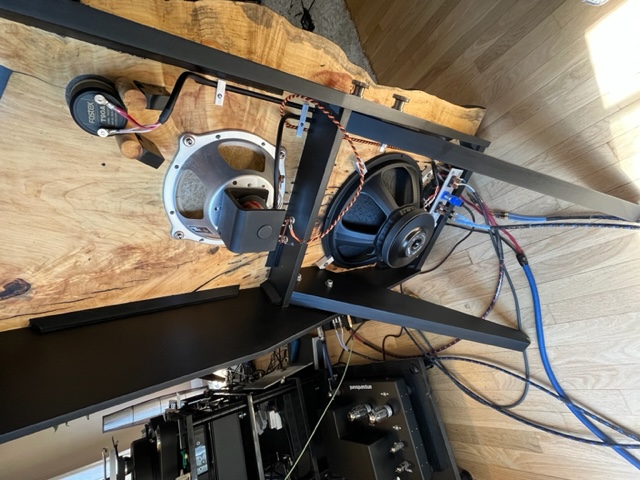
The woofer amp you choose is fed a signal from a miniDSP branded box fed by a separate output from your preamplifier, just like a typical subwoofer arrangement. The miniDSP provides a level, crossover frequency (typically 100hz), slope (24 db per octave recommended), and room correction equalization. Think of it as assembling a custom dsp controlled subwoofer, but with the driver already chosen and mounted in the speaker baffle.
Set-Up
Rich Pinto of Treehaus Audiolab drove from Connecticut to Casa de la McAudiophile in Noth Ca-lina to deliver and set up. I enjoyed discussing speaker design, SET amps, and computer hacks for a BMW i3. In addition to designing and building cool speakers, Rich is a good hang. I had a blast; thanks, Rich!
After putting the arms on the speakers that balance and serve to angle the baffle, we set about moving them around. Rich suggested we find a good spot while listening without the woofer being on. This enabled us to get usable low-frequency extension from the full-range field-coil driver without the pre-dsp-adjusted woofer muddying the water.
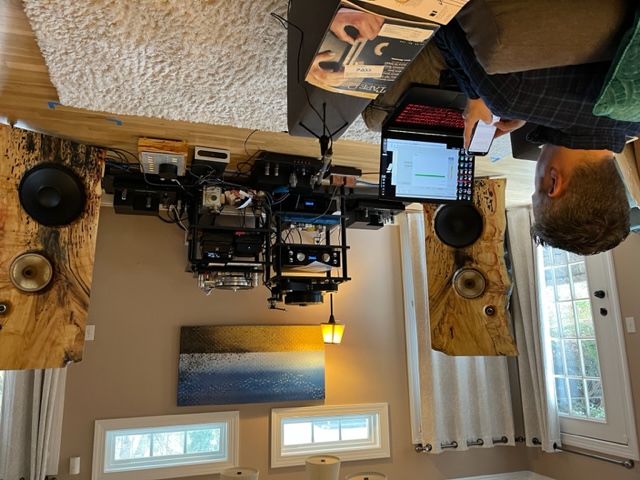
Next up: DSP party time.
Rich uses REW software and a calibrated mic as the detection software.
The miniDSP 2X4 HD box and its app are used for woofer eq, crossover, and level. He installed those apps and performed the set-up on my laptop so I could play around after he left. Note: don’t be confused by the term crossover because, in a National Treasure, it doesn’t cross over to another driver. It’s simply a low-pass filter to roll off unwanted frequencies not needed from the woofer.
Being a first-degree acoustics nerd, I had fun watching Rich put his measurement microphone in several places at and around my listening chair. Left and Right woofer output was sampled separately as REW enables multichannel. Once REW ingested all the tone sweeps, he told the program to average the curves. The information about the woofer output in my room is what REW uses to calculate a correction curve. Then, that info is imported to the miniDSP to do the correcting.
If all this seems daunting or sounds overly complex, don’t worry: No audiophiles were harmed in the making of this movie, I mean room correction.
Time For A Listen
I’m not gonna lie; a pair of large, live-edge, three-way, 15” powered woofer speakers in my listening room was thrilling. The National Treasures give off quite a vibe. But would their mere physical presence imbue my listening experience positively? Or would it detract from me getting into the music? I was about to find out.
All we had left to decide was which power amp Mr. Treasure (call me Nate) would use for the full-range/tweeter drivers.
At HiFi shows, Treehaus uses 300B vacuum tube amplifiers of their design to power the system's full range/tweeter section. These are sold separately by Treehaus and can be used with any suitable speaker system. Rich and I agreed beforehand that I would use one of my amps for the review.
We unanimously chose my Ampsandsound - Red October for Nate’s North Carolina debut. Eight watts of single-ended, direct-heated, triode goodness from a pair of Western Electric 300Bs. That was our guess to get a magic carpet ride on those efficient Atelier Rullit full ranges.
Due to the less-is-more nature of the Red October circuit, It takes more juice than usual from a preamplifier (in this case, a VAC Master Pre) to drive to nominal listening levels. This required us to lower the MINIdsp output to the Bel Canto bass speaker amp. Fortunately, the MINIdsp has a handheld remote for this exact task. “It’s good to be king,” I thought to myself as I held the amount of low-frequency power in the palm of my hand. After a few quick bits of reference tracks, I had it dialed in.
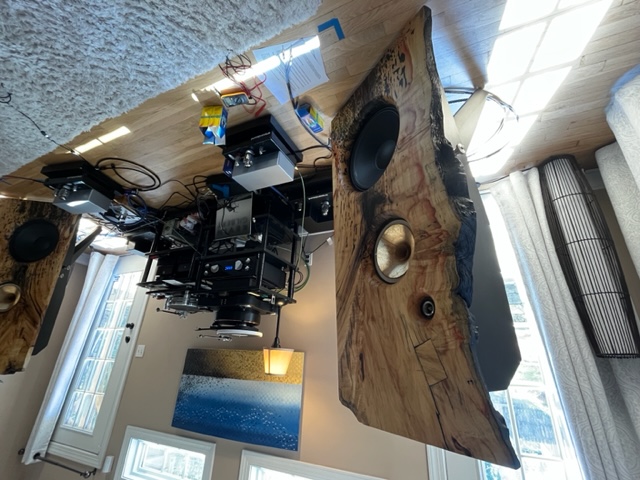
Via Qobuz, I quickly sampled mostly music I had mixed or mastered. I think I mumbled something to Rich like, “This is really good.”
Later, after trying my Ampsandsound - Bryce and Zion Monos, Rich and I felt the 42 watt, push-pull Zions, were the ticket. After another bass level adjustment using the miniDSP remote (to match the Zion’s input sensitivity,) it was finally time for some right-brain listening.
While things sounded mighty fine, it would take a minute to acclimate to the size and unique texture of what I was hearing. My music-listening neural pathways would need some time to rewire to this altogether new listening experience using the Treehaus Audiolab - National Treasure.
Since becoming a HiFi reviewer, I’ve learned a few things about how I listen. My day job has trained me to rapidly judge sound quality. To be a good mixer, especially a good mastering engineer, too much time pondering what you hear is the worst thing you can do. However, as much as I value my rapid and automatic analysis of what’s coming out of a HiFi system, this approach can work against me when evaluating HiFi components’ sound quality. I feel like I’ve learned how to walk a fine line. That line is between rejecting what doesn’t instantly fit the curve in my mental algorithm or eventually ignoring sonic deficiencies due to the reprogramming that occurs from long-term neural acclimation.
The “newness” I heard from the music coming out of the pair of National Treasures was impressive from the start. Eventually, things morphed into an even more enjoyable listen.
The Part I Knew Would Be Difficult - How Does It Sound?
I never felt these speakers tried to dig out every last detail of a recording by being laser focused or distortionless. This is NOT to say it’s colored-sounding or sloppy in any way, far from it. I’ll say organic, without implying lots of tonal color. The National Treasure is not the typical high-end loudspeaker listen. It’s something more.
I found these speakers to be a remarkably satisfying listen, yet difficult to describe in words.
The first thing that hit me about the National Treasure (and stayed constant) was the alluring midrange. Boy, do those full-range drivers do a thing. It’s no secret how crucial midrange reproduction is to satisfying long-term listenability. The Treehaus midrange communicates. It was a direct conduit to the heart and soul of whatever music I played. It communicates in a manner that doesn’t scream ultra hi-rez, mission-critical frequency response flatness.
I couldn’t even put my finger on the exact frequency area(s) that departed from total linearity, although I never felt it was especially flat. However, I started having a lot of respect for full-range field-coil drivers - this one in particular.
I could detect no transition from the Atelier Rullit field coil driver to the Fostex super-tweeter. It’s smooth and provides a hint of sparkle and air that is crucial for a speaker system aiming to reproduce the entire range of recorded music.
The system's low-end is where I had the most psychological hurdle to overcome. I had trouble believing the bass I heard was as good as it was! A conventional paper-coned 15” driver in an open-baffle configuration? C’mon. Okay, maybe it wasn’t Tesla fast like other speaker systems I’ve heard, but it was tightly controlled, plunged deep to the low 40s, and integrated well. Although not at first.
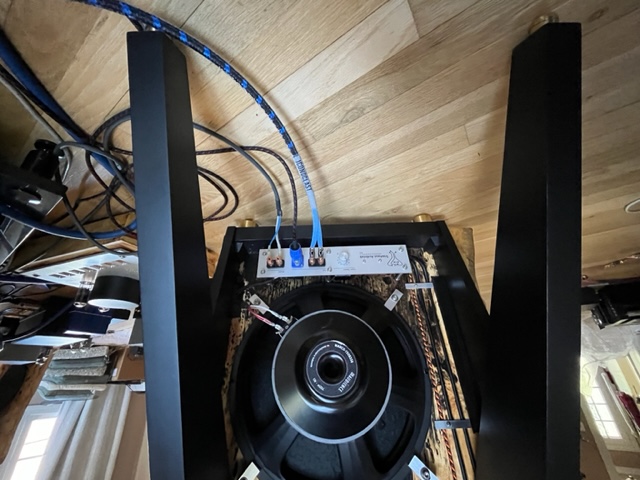 One of my initial listening issues had been a feeling that as good as stuff sounded, top-shelf coherence was missing. Something sounded amiss, but what the hell was it? At one point, I discovered the speaker cables had one woofer out of phase with the other. Ooooops.
One of my initial listening issues had been a feeling that as good as stuff sounded, top-shelf coherence was missing. Something sounded amiss, but what the hell was it? At one point, I discovered the speaker cables had one woofer out of phase with the other. Ooooops.
This was not detected during the first dsp setup because of doing each side separately and without sweeping much above 100 hz.
The coherence issue was solved after fixing my speaker cable polarity faux pas. But the strange thing was how little the low freq output at my listening chair changed. I mean, it got a little louder, but not night and day. I would have heard the phase issue immediately if this had been a more conventional speaker system.
Thinking about how an open-baffle speaker system must be energizing my room was the only thing I could come up with to explain the woofer phase correction being subtle. This also may have been responsible for my lack of doing excessive position tweaks to find the perfect spot.
I did, however, redo the dsp eq, changed the slope, and lowered the frequency of the low pass filter. This final change gave more upper bass/lower mid linearity and more overall sound coherence. The character of the low end remained the same but was better integrated.
When I played recordings with lots of sound-stage information, this was delineated honestly and with plenty of depth and width. The center image focus was impressive, with the requisite vocal palpability. In Bowie’s Hunky Dory masterpiece “Life On Mars,” David was anchored in space and seemed alive.
In other speakers, I’ve heard more impressive outside-of-the-speakers imaging. However, the scale and density of what came out of the National Treasure were so richly textured and dynamically nuanced that this was never an issue.
I did not, however, hear the much-vaunted “lack of any box colorations” thing. Instead, the National Treasure simply sounded great.
I also enjoyed the ability to change the voltage on the box that drives the field coil. I’m unsure what the total range is, but Rich suggested I try the 100 to 170 volts area. The higher the voltage, the faster the midrange seemed. It was too zippy at 170, so I settled on 150 volts for most of my listening time. No voltage setting was bad, just whatever floats your boat.
Conclusion
I was not only relieved that the Treehaus Audiolab - National Treasure sounded superb in my listening room, I had a blast listening to these unique speakers. I was sorry to see them go.
Before I figured out the woofer phase issue, an audiophile friend with great ears came by to listen. He said, "These are the best open-baffle speaker I’ve ever heard.” Then on a second listen, post phase-issue fix: “These are some of the best sounding speakers, regardless of design!”
After Rich retrieved his babies, I returned my QLN Prestige Fives to the system.
Wait, what happened? Where’s that luscious wall of sound I reveled in for a few months? These sound kind of small. Maybe I need a new reference speaker? I won’t answer that, but I got right with my long-time loves after a get-reacquainted period.
Since these are custom-built, Treehaus offers various baffle appearances in different woods and finishes. The Phantom Of Luxury model is larger, with a higher level of drivers for all three spots. I fantasized about a National Treasure with the upgraded full-range field-coil driver of the Phantom Of Luxury.
Allow me to go back to my food buffet metaphor for a second.
When audiophiles research what speaker might expand their sonic taste palette, some would feel more confident to hear/taste a speaker built in a factory that looks like they take on NASA contracts during downtime.
Treehaus speakers are not that. But you would be mistaken to think it’s three drivers randomly put on a rustic-looking wood slab. The National Treasure hides in plain sight as a hand-crafted speaker system that looks comfortable in a ski lodge - but it’s much more. I found the sound as engaging as any proper high-end speaker system - and more so than many. It has a unique flavor to its sound and visual appeal, along with a legit performance-to-price ratio.
Whether a lover or a hater of open-baffle speaker systems, any serious audiophile who has the chance should put ears on these beauties should. You won’t regret it. You may fall in love. You’ve been warned.
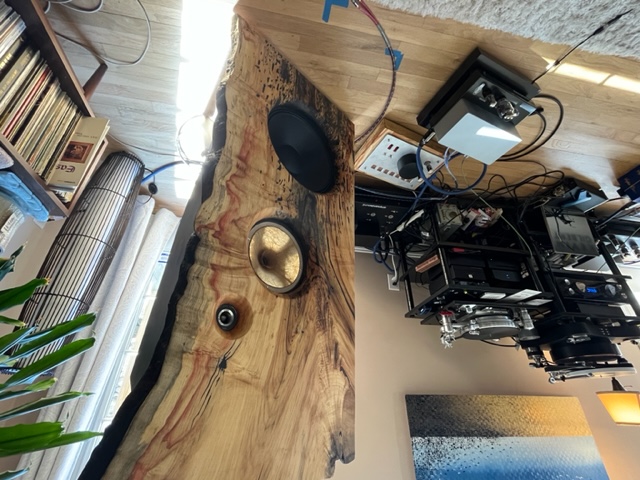
Specifications
National Treasure
Open-baffle speaker, approximately 24” wide and 52” tall in live edge Walnut or Elm.
Hard Maple side-walls and legs.
Atelier Rullit “Aero” full-range field coil driver with tube rectified power supply.
Ferrite Magnet 15” woofer
Fostex T90A Alnico Super Tweeter.
High quality crossover using Miflex capacitors and Fostex L-pad super tweeter attenuation.
Input panel includes Cardas connectors for speakers, and Neutrik PowerCon for field coil power.
MiniDSP module for woofer (crossover points and DSP).
Field Coil power supply cables included (Belden 9497).
Additional options available upon request.
Manufacturer Information
business number: 917-855-9649
email: info@treehauaududiolab.com


